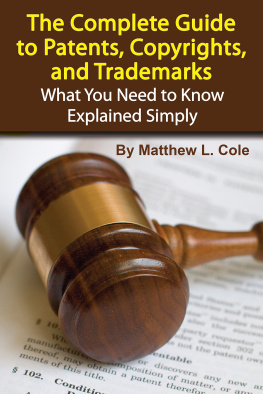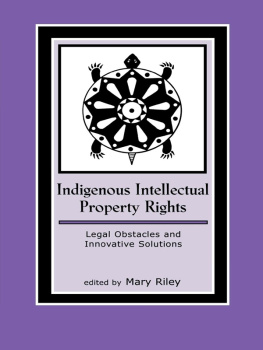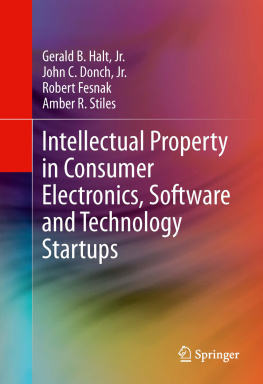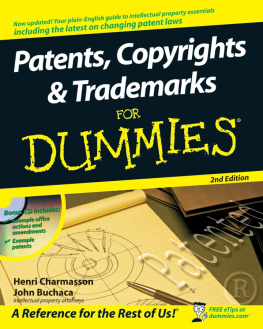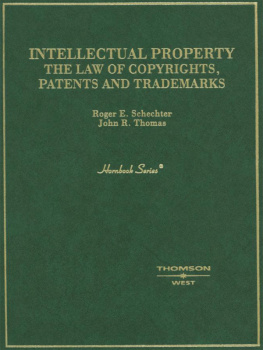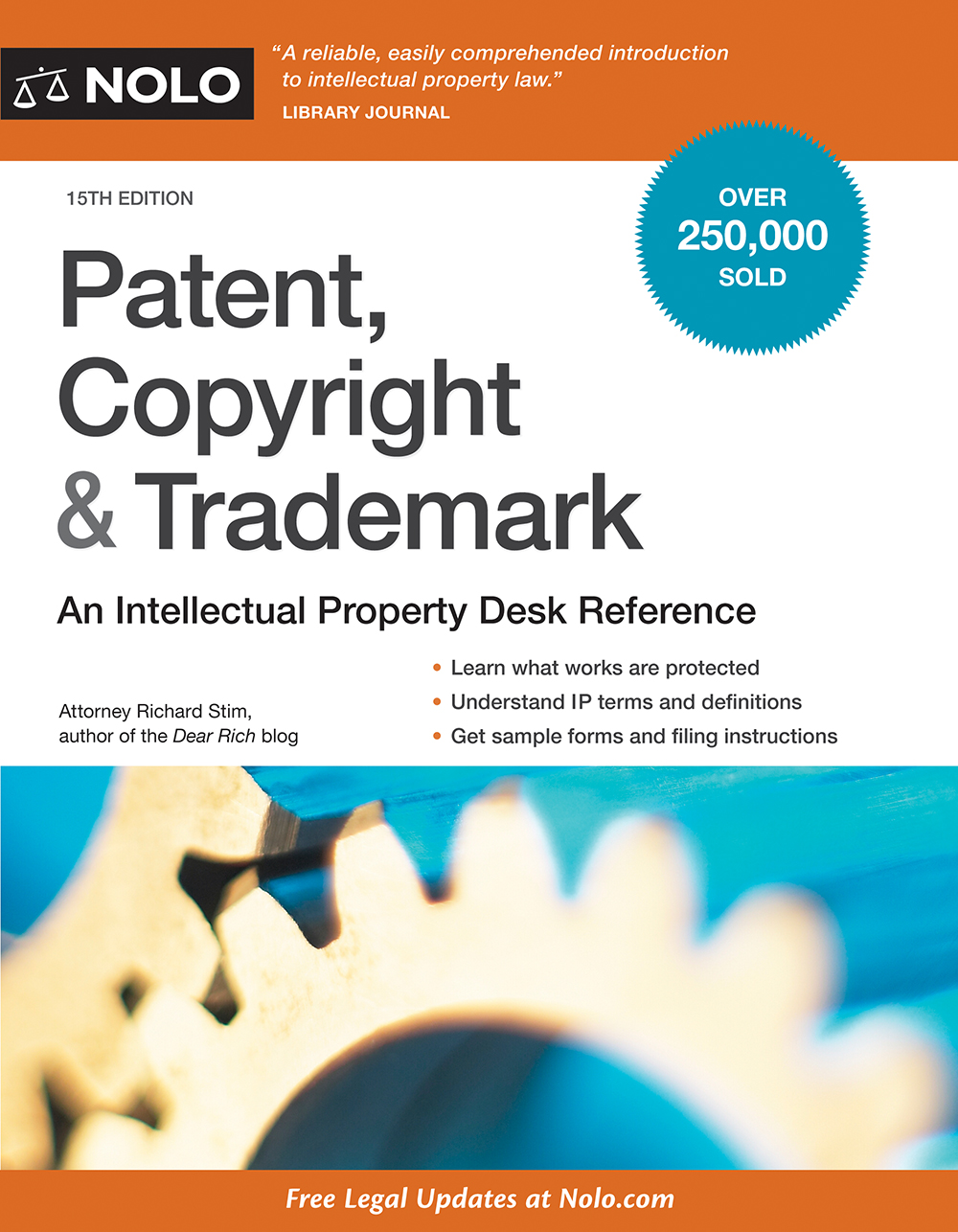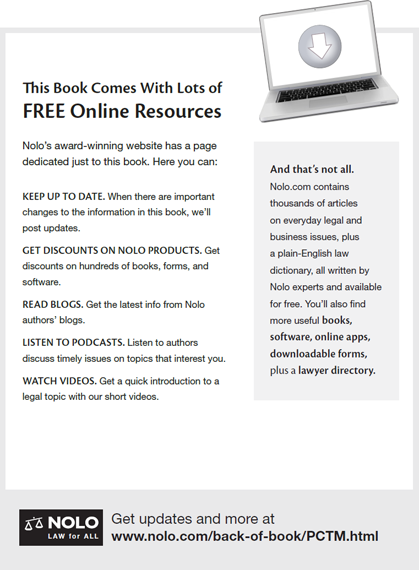

| The Trusted Name (but dont take our word for it) |
In Nolo you can trust.
THE NEW YORK TIMES
Nolo is always there in a jam as the nations premier publisher of do-it-yourself legal books.
NEWSWEEK
Nolo publications... guide people simply through the how, when, where and why of the law.
THE WASHINGTON POST
[Nolos]... material is developed by experienced attorneys who have a knack for making complicated material accessible.
LIBRARY JOURNAL
When it comes to self-help legal stuff, nobody does a better job than Nolo...
USA TODAY
The most prominent U.S. publisher of self-help legal aids.
TIME MAGAZINE
Nolo is a pioneer in both consumer and business self-help books and software.
LOS ANGELES TIMES
15th Edition
Patent,
Copyright
& Trademark
An Intellectual Property Desk Reference
Attorney Richard Stim

FIFTEENTH EDITION | JANUARY 2018 |
Cover Design | SUSAN PUTNEY |
Book Design | SUSAN PUTNEY |
Proofreading | ROBERT WELLS |
Index | ACCESS POINTS INDEXING |
Printing | BANG PRINTING |
ISSN: 2326-3946 (print)
ISSN: 2332-4368 (online)
ISBN: 978-1-4133-2462-4 (pbk)
ISBN: 978-1-4133-2463-1 (epub ebook)
This book covers only United States law, unless it specifically states otherwise.
Copyright 1996, 1997, 1999, 2000, 2002, 2003, 2004, 2006, 2007, 2009, 2010, 2012, 2014, 2016, and 2018 by Nolo and Richard Stim. All rights reserved. The NOLO trademark is registered in the U.S. Patent and Trademark Office. Printed in the U.S.A.
No part of this publication may be reproduced, stored in a retrieval system, or transmitted in any form or by any means, electronic, mechanical, photocopying, recording, or otherwise without prior written permission. Reproduction prohibitions do not apply to the forms contained in this product when reproduced for personal use. For information on bulk purchases or corporate premium sales, please contact the Special Sales Department. Call 800-955-4775 or write to Nolo, 950 Parker Street, Berkeley, California 94710.
Please note
We believe accurate, plain-English legal information should help you solve many of your own legal problems. But this text is not a substitute for personalized advice from a knowledgeable lawyer. If you want the help of a trained professionaland well always point out situations in which we think thats a good ideaconsult an attorney licensed to practice in your state.
Dedication
This book is dedicated to Steve Elias who passed away in 2012. Steve wrote and edited the first three editions at a time when intellectual property was just beginning to surface in mainstream media. His contributions to the legal self-help movement were crucial to its success and the world is a different place for his efforts.
About the Author
Richard Stim is an attorney specializing in intellectual property and the author of several other intellectual property books, including Getting Permission: How to License & Clear Copyrighted Materials Online & Off (Nolo); Music Law: How to Run Your Bands Business (Nolo); and Profit From Your Idea: How to Make Smart Licensing Deals (Nolo). He answers intellectual property questions at his blog, Dear Rich (www.dearrichblog.com).
Table of Contents
Introduction
A photographer is wondering why an advertising agency can copy her photographs without permission. An inventor is wondering why he cannot stop a foreign manufacturer from making his patented invention. A man named McDonald is wondering why he cannot open a restaurant called McDonalds. And a woman who spends $600 on a software program is wondering why its illegal to share copies with her friends.
Welcome to the world of intellectual property.
Writers, inventors, and artists transform ideas into tangible property. When this property qualifies under law for protection its known as intellectual property (or IP)for example, patents, copyrights, trademarks, and trade secrets. Creators of IP are granted certain rights. For example, the author of a book can prevent others from copying it; and the owner of a patented invention can prevent others from making, using, or selling the device.
After a time, these exclusive rights may be lost or taken from the owner and given to the public. For example, copyright protection has ended for Mark Twain and anyone is free to copy his books Huckleberry Finn and The Adventures of Tom Sawyer. The patent on the original roller blade invention has expired and companies are now free to copy the device.
But not all products of the mind can achieve protection under intellectual property law. Determining what can be protected and why used to be the exclusive domain of patent, copyright, and trademark lawyers. Unfortunately, few businesses, nonprofits, or educational institutions can afford to call an attorney with every question. And lately, there are a lot more questions. Globalization, digital data, and the Internet have all contributed to a greater need for information about IP.
The truth is that intellectual property is not an inscrutable discipline. Anybody can understand the basics. This book is proof that IP law is not a mystery. For over 20 years, engineers, scientists, businesspeople, academics, and attorneys have used this book as a reference for understanding basic patent, copyright, trademark, and trade secret principles. This helpful desk reference has evolved to include hundreds of definitions, statutes, forms, and bits of how-to information about protecting and preserving intellectual property.
So before you pick up the phone to call an attorney, check out this book. It may save you time and money... and it will hopefully make your job easier, your employer more secure, and your business more prosperous.
Intellectual Property Law: The Basics
Intellectual property laws, along with court decisions and regulations, establish rules for the following activities:
the registration and administration of intellectual property
selling or licensing of intellectual property, and
resolving disputes between companies making or selling similar intellectual property products and services.
Intellectual property laws dont prevent someone from stepping on the owners rights. But the laws do give an owner the ammunition to take a trespasser to court. This is the most well-known benefit of owning intellectual property: The owner acquires exclusive rights and can file a lawsuit to stop others who use the property without authorization. If the intellectual property owner does not confront the person or company who has acted without permission, then the illegal activity will likely continue.


